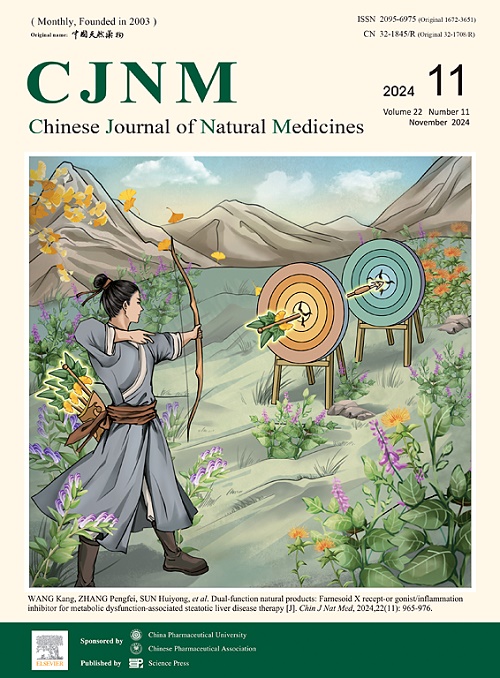Structurally diverse sesquiterpenoids with anti-MDR cancer activity from Penicillium roqueforti
IF 4.9
2区 医学
Q1 INTEGRATIVE & COMPLEMENTARY MEDICINE
引用次数: 0
Abstract
Five novel nor-eremophilane-type sesquiterpenoids, peniroqueforins E–H and J (1–4 and 7), two new eremophilane-type sesquiterpenoids, peniroqueforins I and K (5 and 8), and a new eudesmane-type sesquiterpenoid, peniroqueforin L (9), along with four known compounds (6 and 10–12), were isolated and characterized from fungus Penicillium roqueforti (P. roqueforti). The structures and absolute configurations of these compounds were determined through comprehensive spectroscopic analyses, electronic circular dichroism (ECD) data analyses, and single-crystal X-ray diffraction methods. The anti-multi-drug resistance (MDR) cancer activity of these compounds was evaluated using SW620/Ad300 cells. Notably, the half maximal inhibitory concentration (IC50) value of paclitaxel (PTX) combined with 1 in SW620/Ad300 cells was 50.36 nmol·L−1, which was 65-fold more potent than PTX alone (IC50 3.26 μmol·L−1). Subsequent molecular docking studies revealed an affinity between compound 1 and P-glycoprotein (P-gp), suggesting that this nor-eremophilane-type sesquiterpenoid (1) could serve as a potential lead for MDR reversal in cancer cells through P-gp inhibition.
具有抗多药耐药肿瘤活性的结构多样倍半萜
从真菌roqueforti青霉菌(P. roqueforti)中分离到5个新的非青霉烯型倍半萜类,peniroqueforins E-H和J(1-4和7),2个新的青霉烯型倍半萜类,peniroqueforins I和K(5和8),1个新的青霉烯型倍半萜类,peniroqueforin L(9),以及4个已知化合物(6和10-12)。通过综合光谱分析、电子圆二色性(ECD)数据分析和单晶x射线衍射方法确定了这些化合物的结构和绝对构型。利用SW620/Ad300细胞对这些化合物的抗多药耐药(MDR)肿瘤活性进行了评价。紫杉醇(PTX)联合1对SW620/Ad300细胞的半数最大抑制浓度(IC50)值为50.36 nmol·L−1,是紫杉醇单用(IC50为3.26 μmol·L−1)的65倍。随后的分子对接研究揭示了化合物1与p糖蛋白(P-gp)之间的亲和力,这表明这种非eremophile型倍半萜类(1)可能通过抑制P-gp而成为逆转癌细胞MDR的潜在先导物。
本文章由计算机程序翻译,如有差异,请以英文原文为准。
求助全文
约1分钟内获得全文
求助全文
来源期刊

Chinese Journal of Natural Medicines
INTEGRATIVE & COMPLEMENTARY MEDICINE-PHARMACOLOGY & PHARMACY
CiteScore
7.50
自引率
4.30%
发文量
2235
期刊介绍:
The Chinese Journal of Natural Medicines (CJNM), founded and sponsored in May 2003 by China Pharmaceutical University and the Chinese Pharmaceutical Association, is devoted to communication among pharmaceutical and medical scientists interested in the advancement of Traditional Chinese Medicines (TCM). CJNM publishes articles relating to a broad spectrum of bioactive natural products, leading compounds and medicines derived from Traditional Chinese Medicines (TCM).
Topics covered by the journal are: Resources of Traditional Chinese Medicines; Interaction and complexity of prescription; Natural Products Chemistry (including structure modification, semi-and total synthesis, bio-transformation); Pharmacology of natural products and prescription (including pharmacokinetics and toxicology); Pharmaceutics and Analytical Methods of natural products.
 求助内容:
求助内容: 应助结果提醒方式:
应助结果提醒方式:


